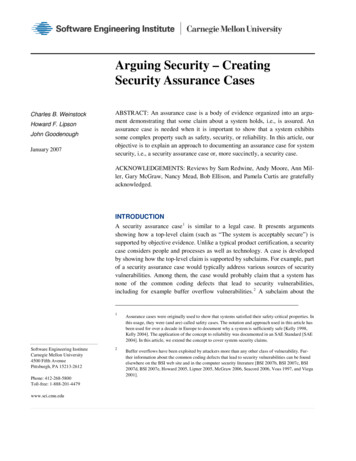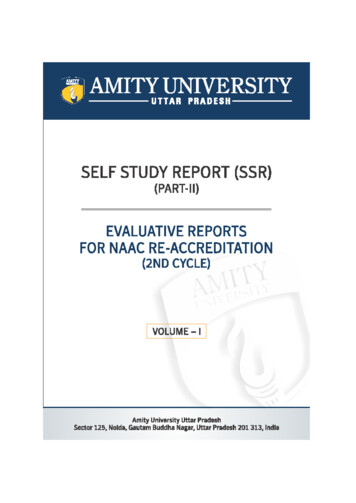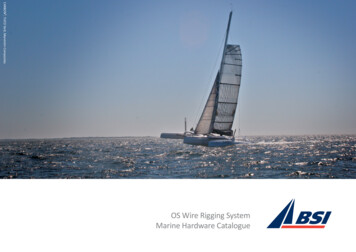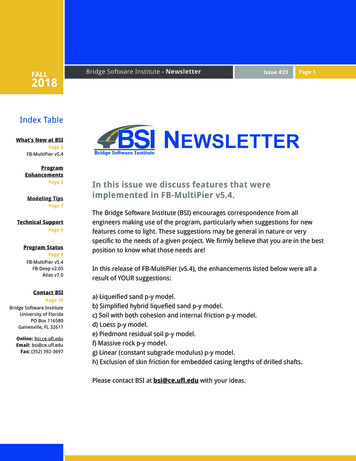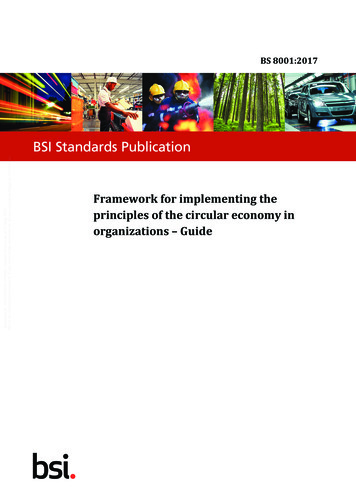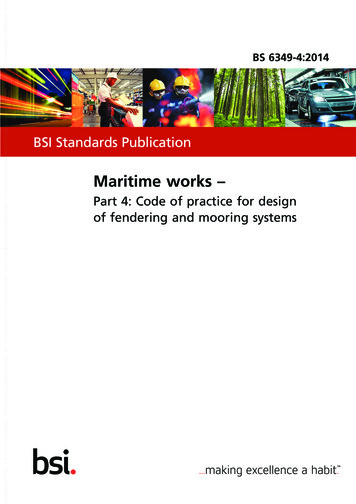
Transcription
BS 6349-4:2014BSI Standards PublicationMaritime works –Part 4: Code of practice for designof fendering and mooring systems
BS 6349-4:2014BRITISH STANDARDPublishing and copyright informationThe BSI copyright notice displayed in this document indicates when the documentwas last issued. The British Standards Institution 2014Published by BSI Standards Limited 2014ISBN 978 0 580 66969 9ICS 47.020.99; 93.140The following BSI references relate to the work on this document:Committee reference CB/502Draft for comment 13/30199621 DCPublication historyFirst published March 1985Second edition, October 1994Third (present) edition, June 2014Amendments issued since publicationDateText affected
BRITISH STANDARDBS 6349-4:2014ContentsForewordiiiSection 1: General11Scope12Normative references3Terms, definitions and symbolsSection 2: Fendering12444.14.24.34.44.54.64.7General principles 4Provision and overall design of fendering systemsSelection and design of fenders 7Vessel characteristics 7Fender layout for berths and other locations 9Berthing procedure 13Berthing reactions and load distribution 15Moored reactions 1855.15.25.3Calculation of berthing energies 18Characteristic and design berthing energy 18Calculation of characteristic berthing energies for alongside berthingCalculation of berthing energies for ferry and Ro-Ro berths 2266.16.26.36.46.56.66.76.86.9Selection of fenders and fender types 23General 23Materials and workmanship 23Fenders using elastomeric units 23Torsion arm fenders 25Pneumatic and foam-filled fenders 25Flexible dolphins 26Shear capacity of fenders 29Fender panels 29Mounting and suspension 30Section 3: Mooring4193277.17.27.3Principles of good mooringGeneral 32Mooring lines 32Mooring layouts 333288.18.28.38.48.5Actions acting on the moored vessel 36General 36Wind and currents 36Hydrodynamic forces 36Tidal rise and fall and change in draught or trim due to cargooperations 38Ice 3899.19.29.3Loads on mooring points 39General 39Calculation methods 39Design of mooring point structure1010.110.210.310.410.510.6On-shore mooring equipment 41Materials 41Mounting and fixing 41Bollards 42Quick release mooring hooks 43Capstans 43Vacuum mooring systems 4441 The British Standards Institution 2014 i
BS 6349-4:2014BRITISH STANDARDBibliography45List of figuresFigure 1 – Geometry of vessel with bulbous bow 8Figure 2 – Hull and cope geometry at impact 10Figure 3 – Fender layout on a continuous quay 10Figure 4 – Fender layout for three island berth 11Figure 5 – Fender layout for five island berth 12Figure 6 – Geometry of vessel approach to berth 13Figure 7 – Ferry and Ro-Ro vessel berthing 14Figure 8 – Hull and fender geometry at impact 17Figure 9 – Design berthing velocity as function of navigation conditions and sizeof vessel 20Figure 10 – Flexible dolphins 28Figure 11 – Typical mooring pattern for continuous quay 34Figure 12 – Optimum angles of mooring lines for island tanker berth 35Figure 13 – Vessel under influence of stand-off force 37Figure 14 – Effect of rise and fall of tide and change in draught or trim 39List of tablesTable 1 – Typical fendering locations 5Table 2 – Vessel categories 6Table 3 – Guidance on hull pressure 16Table 4 – Coefficients of friction of fender facing materials in dry conditions 29Table 5 – Mooring point loads for general cargo vessels and bulk carriers 41Table 6 – Mooring bollards 42Summary of pagesThis document comprises a front cover, an inside front cover, pages i to iv,pages 1 to 46, an inside back cover and a back cover.ii The British Standards Institution 2014
BRITISH STANDARDBS 6349-4:2014ForewordPublishing informationThis part of BS 6349 is published by BSI Standards Limited, under licence fromThe British Standards Institution, and came into effect on 30 June 2014. It wasprepared by Technical Committee CB/502, Maritime works. A list oforganizations represented on this committee can be obtained on request to itssecretary.SupersessionThis part of BS 6349 supersedes BS 6349-4:1994, which is withdrawn.Relationship with other publicationsBS 6349 is published in the following parts 1): Part 1-1: General – Code of practice for planning and design for operations; Part 1-2: General – Code of practice for assessment of actions; 2) Part 1-3: General – Code of practice for geotechnical design; Part 1-4: General – Code of practice for materials; Part 2: Code of practice for the design of quay walls, jetties and dolphins; Part 3: Code of practice for the design of shipyards and sea locks; Part 4: Code of practice for design of fendering and mooring systems; Part 5: Code of practice for dredging and land reclamation; Part 6: Design of inshore moorings and floating structures; Part 7: Guide to the design and construction of breakwaters; Part 8: Code of practice for the design of Ro-Ro ramps, linkspans andwalkways.Information about this documentThis is a full revision of the standard, and introduces the following principalchanges: reduction of informative content, with informative guidance separated fromrecommendations; general updating to reflect latest practice; change in definitions of berthing mode and navigation conditions.Use of this documentAs a code of practice, this part of BS 6349 takes the form of guidance andrecommendations. It should not be quoted as if it were a specification andparticular care should be taken to ensure that claims of compliance are notmisleading.Any user claiming compliance with this British Standard is expected to be able tojustify any course of action that deviates from its recommendations.1)2)A new part 9 is in preparation.In preparation. The British Standards Institution 2014 iii
BS 6349-4:2014BRITISH STANDARDPresentational conventionsThe provisions in this standard are presented in roman (i.e. upright) type. Itsrecommendations are expressed in sentences in which the principal auxiliaryverb is “should”.Commentary, explanation and general informative material is presented insmaller italic type, and does not constitute a normative element.Contractual and legal considerationsThis publication does not purport to include all the necessary provisions of acontract. Users are responsible for its correct application.Compliance with a British Standard cannot confer immunity from legalobligations.iv The British Standards Institution 2014
BRITISH STANDARDBS 6349-4:2014Section 1: General1 ScopeThis part of BS 6349 gives recommendations and guidance on the design offendering systems and layouts, mooring devices and mooring system layouts,principally for commercial vessels with a minimum displacement of 1 000 t.NOTE Some of the provisions in this part of BS 6349 might be applicable to othertype of vessels such as naval vessels, provided that the particular vessel characteristicsand berthing/mooring procedures are taken into account.2 Normative referencesThe following documents, in whole or in part, are normatively referenced in thisdocument and are indispensable for its application. For dated references, onlythe edition cited applies. For undated references, the latest edition of thereferenced document (including any amendments) applies.Standards publicationsASTM F2192/05, Standard test method for determining and reporting theberthing energy and reaction of marine fendersBS 6349-1:2000, Maritime structures – Part 1: Code of practice for general criteriaBS 6349-1-1:2013, Maritime works – Part 1-1: General – Code of practice forplanning and design for operationsBS 6349-1-4, Maritime works – Part 1-4: General – Code of practice for materialsBS 6349-2, Maritime works – Part 2: Code of practice for the design of quaywalls, jetties and dolphinsBS EN 1993 (all parts), Eurocode 3 – Design of steel structuresBS EN 1995 (all parts), Eurocode 5 – Design of timber structuresBS EN 60079-10-1, Explosive atmospheres – Part 10-1: Classification of areas –Explosive gas atmospheresBS ISO 17357 (all parts), Ships and marine technology – Floating pneumaticrubber fendersOther publications[N1]US ARMY CORPS OF ENGINEERS (USACE), NAVAL FACILITIES ENGINEERINGCOMMAND (NAVFAC), AIR FORCE CIVIL ENGINEER CENTER (HQ AFCEC) andNATIONAL AERONAUTICS AND SPACE ADMINISTRATION (NASA). Unifiedfacilities guide specifications – Division 35: Waterway and marineconstruction – Section 35.59.13.16: Marine fenders. USACE/NAVFAC, 2011. 3)[N2]EUROPEAN ORGANISATION FOR TECHNICAL APPROVALS. Design of bondedanchors. TR 029. Brussels: EOTA, 2007.3)Available from 13.16.pdf[last accessed 25 June 2014]. The British Standards Institution 2014 1
BS 6349-4:2014BRITISH STANDARD3 Terms, definitions and symbols3.1Terms and definitionsFor the purposes of this part of BS 6349, the terms and definitions given inBS 6349-1-1:2013 and the following apply.3.1.1bertharea in a port dedicated to the mooring of a vessel and typically equipped withfenders and mooring equipmentNOTE3.1.2A berth for a large vessel can be used to moor two or more smaller vessels.berthing lineseaward face of a berth including the uncompressed fendering system3.1.3copetop edge of a quay or jetty adjacent to a berth3.1.4design vesselvessel for which the fendering and mooring systems are designed to permit it tosafely berth and be moored under the environmental operating limitsNOTE Where a berth is to accommodate a range of vessels, there will be severaldesign vessels, including as a minimum both the largest and smallest.3.1.5fenderitem of port equipment designed to keep a vessel from touching the berthstructure without damaging itself or the vessel or the berth structureNOTE 3.1.6The components of a fender can include one or more of the following:energy absorbing unit(s), e.g.: elastomeric unit(s); pneumatic unit(s); foam-filled unit(s); fender panel; facing material; fender pile; timber sections; fender chains: to assist in supporting the static weight of fender panels; to control movement of fender panel; to prevent movement of panels out from berthing line.fendering systemall the fenders provided for a berth3.1.7flat side of vesselpart of the side of a vessel between the bow and stern that is flat, vertical andparallel to the axis of the vesselNOTE2 Sometimes also referred to as parallel midships or parallel mid-body. The British Standards Institution 2014
BRITISH STANDARD3.2BS 6349-4:2014SymbolsFor the purposes of this part of BS 6349, the following symbols apply.Bbeam of vessel, in metres (m)Cbblock coefficient of the vessel hullCCberth configuration coefficientCEeccentricity coefficientCMhydrodynamic mass coefficientCSsoftness coefficientDvdraught of vessel, in metres (m)ddeflection at the level of the application of the load, in metres (m)ECcharacteristic energy to be absorbed by the fendering system, inkilonewton metres (kN·m)EDdesign energy to be absorbed by the fendering system, in kilonewtonmetres (kN·m)EFenergy absorbed by the fender, in kilonewton metres (kN·m)Kradius of gyration of vesselLOAoverall length of vessel, in metres (m)LBPlength of vessel hull between perpendiculars, in metres (m)LLoverall length of largest design vessel, in metres (m)LSoverall length of smallest design vessel, in metres (m)MDdisplacement of vessel, in tonnes (t)Rdistance of the point of contact from the centre of mass of the vessel,in metres (m)RFfender reaction, in kilonewtons (kN)Vcharacteristic velocity of vessel in direction of approach, in metres persecond (m/s)VBcharacteristic velocity of vessel normal to the berthing line at the pointof impact, in metres per second (m/s)αangle of approach of vesselγangle between the line joining the point of contact to the centre ofmass of the vessel and the normal to the axis of the vesselµcoefficient of friction The British Standards Institution 2014 3
BS 6349-4:2014BRITISH STANDARDSection 2: Fendering4 General principles4.1Provision and overall design of fendering systemsBerths should be provided with a suitable fendering system to protect berthstructures and vessels from damage, taking into account operating conditions asdefined in BS 6349-1-1:2013 and stated in the facility operating manual, unless aclear justification can be made that such a system is not required.NOTE 1 Historically it has been the practice in some ports not to provide fenderingto berths other than simple timber rubbing strips, particularly where they aresituated in sheltered locations such as impounded dock basins. For commercialvessels, and where berths are situated in more exposed locations such as the outerreaches of rivers and in the open sea, fendering systems are widespread.The fendering system should be designed taking account of:a)the range of vessels berthing;b)the methods used to berth the vessel;NOTE 2 Where a vessel berthing alongside is manoeuvred by tugs and/or theuse of thrusters, it is generally stopped a short distance off and parallel to theberth. The vessel is then pushed or warped slowly onto the berth, ideallyachieving a gentle contact as near as parallel to the berthing line as possible.NOTE 3 Tugs, launches and other small vessels tend to approach their berthsmore directly than large vessels.NOTE 4 Ferries and roll-on/roll-off (Ro-Ro) vessels approach their berths in adifferent way, which is explained in 4.5.2.c)vessels moored during cargo handling operations;d)vessels moored during extreme events caused by adverse metocean or otherconditions;e)the normal operating conditions of the berth;f)the risks and consequences as a result of an extreme or accidental eventoccurring;g)the features appropriate to the location of the berth, as shown in Table 1;h)the features appropriate to the characteristics of the vessels that areexpected to use the berth, as shown in Table 2;i)the intended service life of the system, making due allowance fordegradation and wear and tear during operations.NOTE 5 The fendering system might need to be designed to work with themooring system to reduce vessel movements.NOTE 6 Fendering systems are required to be suitable for all operational waterlevels that might occur, and with large variations this becomes particularlyimportant. Winds, waves, current and other factors also vary depending on the berthlocation.4 The British Standards Institution 2014
BRITISH STANDARDTable 1BS 6349-4:2014Typical fendering locationsLocationFeatures to be taken into account in the design of the fendering systemImpounded basinsApproximately constant water levelUsually sheltered from high windsLimited fetch for local wave generationNegligible currentRange of vessel sizes limited by lock dimensionsGreater range of water levels than impounded basinsLimited wave exposureLimited currentVariable water level due to changes in river discharge and possibly tideLimited wave exposureVariable currentPossible restricted area available for manoeuvring of vesselsMaximum tidal range and currentsGreater wave exposure than tidal basinsOften dedicated berths with single class or type vesselsFull exposure to wind, wave and currentsUsually specialized trades, e.g. bulk coal, ore, oil (products), LNG, LPGSingle type vessels and handling equipmentVariable water levelLimited lateral movement of vessels within the lockLarge longitudinal movement of vesselsTidal basinsRiver berthsEstuarial and coastalberthsExposed coastal berthsLocks and lock entrances The British Standards Institution 2014 5
BS 6349-4:2014Table 2BRITISH STANDARDVessel categoriesCategoryFeatures to be taken into account in the design of the fendering systemBulk carriersPossible need to be warped along berth for shiploader to change holdsLarge change in draught between empty and fully laden conditionsLoading ramps, slewed or end loading (vessel mounted or shore based)High windage areasVessels might have recessed bollards in hullEnd berthingExtensive flared bows and sterns with liability to strike shore-sideinstallationsParticularly the larger vessels can have a relatively short length of flat sidePotential high windage areasLarge change of draught between empty and fully laden conditionsPossible long occupancy of berthsLow allowable hull pressureSingle type vessels using dedicated berthNeed to avoid fire hazards from sparking or frictionRelatively short length of flat sideHigh windage areasNeed robust fenders for heavy useVessels are usually fitted with beltingCar carriersContainer vesselsGeneral cargo vesselsLNG/LPG carriersMiscellaneous tugs, supplyboats, barges, lighters andfishing boatsPassenger linersRoll on-roll off (Ro-Ro)vesselsTankersTrain and vehicle ferriesLittle change of draught between empty and fully laden conditionHigh windage areasLow allowable hull pressureLoading ramps, slewed or end loading (vessel mounted or shore based)End berthingHigh windage areasVessels are usually fitted with beltingVessels usually berth without the aid of tugsVery low amidships freeboard for coastal tankersLarge change in draught between empty and fully laden conditionsNeed to avoid fire hazards from sparking or frictionQuick turnaroundEnd berthingHigh berthing velocitiesIntensive use of berthHigh windage areasVessels are usually fitted with beltingVessels usually berth without the aid of tugsNOTE Most vessels have bulbous bows. Vessels from all categories could be fitted with belting, particularly smallervessels.6 The British Standards Institution 2014
BRITISH STANDARD4.2BS 6349-4:2014Selection and design of fendersNOTE 1 If the vessel comes alongside at a slight angle to the berth, it usually makesinitial contact with one or two fenders. The vessel then rotates before impacting onfurther fenders.NOTE 2 Generally, the fender loads during berthing are the controlling influenceon the fender selection. However, for offshore ports and for ports with entrances inexposed locations, vessels might berth only during relatively benign conditions, andthe greatest fender loading could occur when the vessel remains at the berth duringstorm events.The fenders should be designed to protect the berth structure against damagefrom vessels and to limit the reactive forces on the vessel hull to acceptablevalues.The range of available fenders of both proprietary and purpose-made types isconsiderable. Selection and design should take account of the factors listedin 4.1 together with:a)types and hull forms of the vessels that are expected to use the berth;b)velocity and angle at which the vessels berth;c)range of water levels and range of freeboards of vessels to beaccommodated;d)offset of fender face to protect quayside equipment;e)limits to the distance between berth cope and side of hull after vessels aremoored in relation to the outreach of oil loading arms, crane jibs,shiploader booms and similar equipment;f)spacing between fenders;g)movement of vessels while moored;h)number of energy absorbing units that absorb the initial impact energy;i)energy to be absorbed by the fenders, having regard to the location andapproach conditions of the berth and its method of operation;j)reactive forces and deflections on both the berth structure and the vesselhull;k)acceleration and deflection limits on berths carrying quay equipment such aspipelines, rail-mounted cranes and shiploaders;l)number of fenders that resist the loads from a vessel when mooredalongside;m) ease with which the berth can be accessed for the maintenance, repair andreplacement of fenders and fender components, including facing materials;n)metocean actions on the fenders, including from ice and debris.The design of the fenders should be integrated with that of the berth structureas not all types of fender are compatible with all types of structure.4.34.3.1Vessel characteristicsGeneralThe characteristics of the design vessels for a particular berth should beestablished.NOTE 1 Where specific data is not available, the data relating to appropriatevessels for the proposed berth as given in BS 6349-1-1:2013, Annex D or similar datasources may be used. The British Standards Institution 2014 7
BS 6349-4:2014BRITISH STANDARDThe design should allow for the vessel’s hull form, e.g. large container vesselsmight have relatively short flat sides and fast ferries might have high sides withlow allowable hull pressure.NOTE 2The vessel plans might be available to determine the vessel characteristics.Where vessels are berthed in a partially laden condition, reference should bemade to vessel plans, load-displacement curves or tables to ascertain the hullform and other vessel characteristics such as draught and displacement values.Where the fendering system is designed primarily for a partially laden or inballast design vessel, the designer should establish the risk of berthing a moreheavily laden vessel, and should take into account the possibility of a fully ladenvessel having to return to the berth.4.3.2Vessels with bulbous bowsVessels with bulbous bows pose a greater collision hazard to most berthstructures than vessels with a conventionally shaped bow. Where such vessels areto be berthed, the underwater geometry of the bow section should be takeninto account in addition to that at the level of contact with the fenderingsystem. The fender spacing, fender outstand after compression and relationshipof the berth’s substructure to the cope face should also be assessed(see Figure 1), to establish a maximum berthing angle α which is acceptablewithout impact between the bow and the berth structure.Figure 1Geometry of vessel with bulbous bowKey1Hull line at fender impact level2Vessel centreline3Hull line at bulb level (below fender level)4Fenders5Maximum berthing angle α6Hull line at main deck levelIt is generally impracticable to provide a fendering system to safeguard theberth structure against accidental head-on or steeply-angled impacts.The designer should therefore establish a maximum safe value of the berthingangle that can be achieved whilst optimizing both the fendering system and thesubstructure layout.8 The British Standards Institution 2014
BRITISH STANDARD4.3.3BS 6349-4:2014BeltingThe design of the fendering system should if appropriate take account ofbelting. Fender panels should be sufficiently long to avoid belting catching thetop or bottom of the panel.NOTE 1 Ferries, and small craft such as tugs and launches, are often fitted withbelting that consists of one or more timber, rubber or steel rubbing strips aroundthe vessel. Occasionally this belting is discontinuous and might be in poor condition.On some vessels it might occur at more than one level, particularly towards the sternof the vessel.NOTE 2 Belting might give highly concentrated loads, catch on edges, giving largevertical loads, and cause localized compression of the fender.4.44.4.1Fender layout for berths and other locationsGeneralThe design of the fendering system should take into account the berth layout.NOTE Fendering systems can be classified into three general categories, i.e. thosefor continuous quays, those for island berths and those for lead-in jetties and locks.Other systems are generally variants of or combinations of these three categories.Fendering systems might be formed of groups of individual fenders or acombination of differing types of fenders.4.4.2Continuous quaysNOTE 1 For the purposes of this subclause, a continuous quay is one that provides astraight continuous berthing line for more than one berth.On continuous quays there is often no precise delineation of individual berths inorder to give flexibility of operation and the accommodation of a wide range ofvessels. In such cases the fendering system should allow a vessel to berth at anyposition along the length of the quay. The fendering system usually consists of aseries of individual fenders, the positioning of which should be in accordancewith the following recommendations.a)The fendering system should prevent the vessel striking the berth structureand cargo handling equipment when berthing on the bow or stern quarters(see Figure 2), and allow sufficient fenders to be mobilized for energyabsorption. Positioning of equipment during berthing should be discussedwith port operations and included in the facility operating manual.NOTE 2 A typical minimum clearance (see item 5 in Figure 2) is 250 mm at thedesign deflection.b)The fendering system should allow vessels to lie alongside with adequatesupport from the fenders along the flat side of the vessel hull.c)The fender spacing should not exceed 0.15LS (see Figure 3). This is based onconventional hull shapes. Where less conventional hull shapes are to becatered for, such as Ro-Ro vessels with a square stern or any vessels with alarge bow and/or stern flare, the spacing should allow for the specific vesselprofiles.NOTE 3 Bow and stern vertical flare varies depending upon the vessel type anddesign. Vertical flare up to 15 is common on container vessels.On continuous quays, varying fendering systems could be used where vesselsand dredge depths vary, and this should be set out in the facility operatingmanual. The British Standards Institution 2014 9
BS 6349-4:2014Figure 2BRITISH STANDARDHull and cope geometry at impactKey1Line of hull at level of impact2Compressed fenders3Cope4Spacing between fenders5Clearance between vessel and berthFigure 3Key123Fender layout on a continuous quayFendersCopeMaximum spacing 0.15Ls to allow vessels to lie alongside for prevention of hull/cope contact(see also Figure 1 and Figure 2)4.4.3Island berthsCOMMENTARY ON 4.4.3Where vessels are berthed about a fixed point such as oil loading arms, the primaryfenders can be concentrated at two or more points depending on the range ofvessels to be accommodated.The spacing of primary fenders should take account of the actual geometry ofthe vessels to be berthed. At least two fenders (one at either side of theplatform) should make full face contact with the flat side of the vessel hull toprovide a sufficient lever arm in the horizontal plane.10 The British Standards Institution 2014
BRITISH STANDARDBS 6349-4:2014NOTE 1 For larger vessels, a minimum of two primary fendering points at each sideof the loading arms can provide a back-up in case of individual fender failure.NOTE 2A symmetrical fendering arrangement is generally a design optimum.In the absence of detailed data, the spacing of berthing dolphins should be inthe range of 0.25LOA to 0.4LOA for the complete range of design vessels(see Figure 4 and Figure 5).A straight berthing line should be adopted to provide optimum support to theflat side of the hull of a moored vessel. Fenders should be selected such as toprevent any overloading of inner fenders at full compression of the outerfenders under design berthing and mooring conditions.Design of the fendering system should take particular account of:Figure 4 prevention of direct impact between vessels and equipment on the loadingplatform; restriction of lateral deflection of the structures to limits acceptable for theequipment; prevention of small vessels snagging the primary fenders, taking account oftide levels and waves; the risk to port operations due to the damage or failure of one or morefenders.Fender layout for three island berthKey1Loading platform2Breasting dolphins with fenders3Design vessel The British Standards Institution 2014 11
BS 6349-4:2014Figure 5BRITISH STANDARDFender layout for five island berthKey1Loading platform2Breasting dolphins with fenders3Design vessels4.4.4Lead-in jetties and lock entrancesFendering systems for lead-in jetties/approaches, for vessels entering intoconfined entrances such as locks, dry docks, ship lift systems and passageways,can be grouped into three categories.a)Fendering for moored vessels in layby berths awaiting entry into confinedentrance. The provision of fendering at layby berths is similar to otherberths, except that extra attention should be given to the increasedlikelihood of vessel wash and surge effects from passing vessels.b)Fendering on the approach to a confined entrance. Approaches to confinedentrances might comprise either a continuous faced structure or a series ofindividual. Particular attention should be given to the potential interactionbetween vessel bow flare and the structures at the lock entrance, especiallyif lead-in jetties are not provided.NOTE Approach walls and lead in jetties are not always common practice forentering confined areas. Guidance on lead-in jetties and approaches to locks isgiven in PIANC Report No. 106 [1].c)12 Fendering required inside the confined area. Within a lock, the principalmovement of a vessel as it enters or leaves a lock is almost parallel to thefender line. As lock water level is raised or lowered, the principal movementof the vessel is vertical. Therefore a different design approach should beadopted, based on experience and liaison with vessel operators. The British Standards Institution 2014
BRITISH STANDARD4.54.5.1BS 6349-4:2014Berthing procedureAlongside berthingThe fender design for vessels that are berthed alongside should assume that thevessel’s movement is at almost right angles to the berth, i.e. with the vesselalmost parallel to the berth, as illustrated in Figure 6.The maximum design angle of approach should be specified in the facilityoperating manual (see 5.2.5 for guidance on values).Figure 6Geometry of vessel approach to berthKey1Centre of mass2Velocity vector3Point of impact4.5.2Ferry and Ro-Ro berthsThe fender design for ferry and Ro-Ro vessels should be based on the berthingmode, of which the three in common use are:a)parallel approach to a row of breasting dolphins or quay and after comingto rest then moving slowly longitudinally to berth end-on against a shoreramp structure;b)direct longitudinal approach to berth end-on against or close to a shoreramp structure but using side breasting dolphins or a quay as a guide;c)parallel approach to berth alongside a quay and using the vessel’s ownramps for vehicle access.Where there is a possibility that more than one of these modes might be used,the designer should allow for the most onerous. The fendering system designshou
This part of BS 6349 is published by BSI Standards Limited, under licence from The British Standards Institution, and came into effect on 30 June 2014. It was . [N1]US ARMY CORPS OF ENGINEERS (USACE), NAVAL FACILITIES ENGINEERING COMMAND (NAVFAC), AIR FORCE CIVIL ENGINEER CENTER (HQ AFCEC) and NATIONAL AERONAUTICS AND SPACE ADMINISTRATION .

